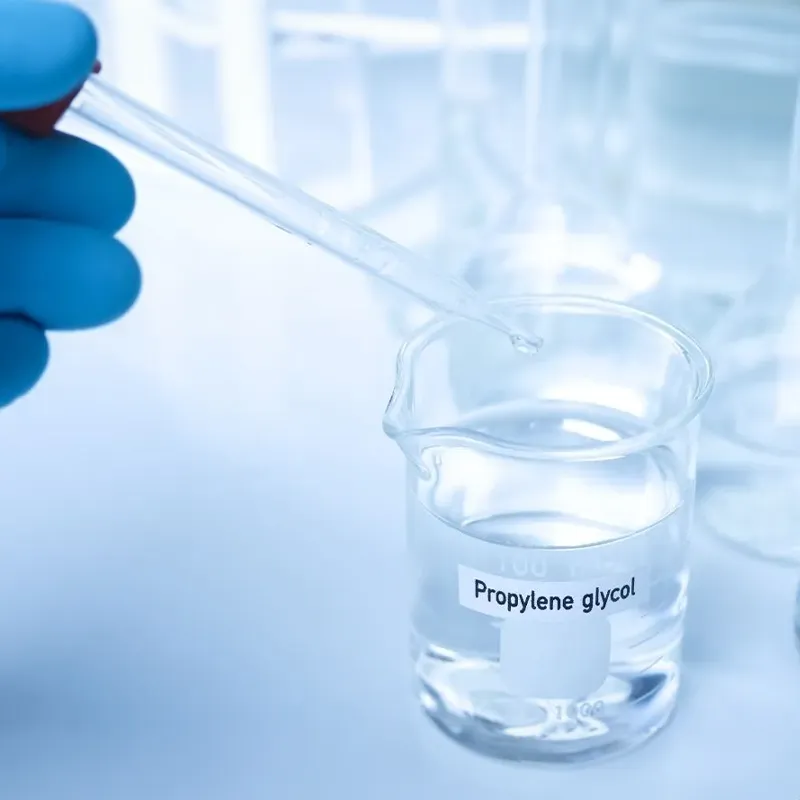 Table of contents
Table of contents
What Is Propylene Glycol?

- Humectant: Attracts and retains moisture from the environment to keep skin hydrated
- Solvent: Helps dissolve and evenly distribute active ingredients
- Emollient: Softens and smoothens skin, improving sensory feel
- Viscosity Controller: Adjusts and stabilizes product texture
- Preservative Booster: Improves the efficacy of certain preservatives
Technical Specifications:
-
AspectsDetails
-
PurityMinimum 99.9% (when cosmetic/pharmaceutical grade)
-
pH Range4.5 - 7.0
-
Viscosity40 - 50 cps at 25°C
-
SolubilityCompletely miscible with water and most organic solvents
- Hydrating: Locks in moisture and helps reduce skin dryness and irritation
- Non-Irritating: Well-tolerated by sensitive skin and suitable for daily use
- Stable: Enhances product shelf life and prevents ingredient separation
- Versatile: Compatible with a wide range of actives, emulsifiers, and polymers
- Texture Enhancer: Improves the glide, spreadability, and skin feel of the final product
Cosmetic vs. Industrial Grade: What's the Real Difference?
When considering how to use propylene glycol in cosmetics, formulators must prioritize not just its functionality but also its grade. At a glance, propylene glycol may look the same across grades, but when it comes to formulation safety, performance, and compliance, the differences are significant. Here is a detailed breakdown of the core distinctions between cosmetic and industrial-grade propylene glycol. 1. Purity & Certification Standards-
SpecificationCosmetic Grade (USP/FCC)Industrial Grade
-
Purity≥99.5%Often lower, around 95–99%
-
CertificationUSP (United States Pharmacopeia), FCCNo certification or lower industrial standard
-
Cosmetic Grade Propylene GlycolIndustrial Grade Propylene Glycol
-
Designed for use in skincare, haircare and pharmaceutical formulations.Intended for non-cosmetic uses, such as antifreeze, de-icing agents, heat-transfer fluids, paints, coatings, and adhesives.
-
Adheres to strict Good Manufacturing Practices (GMP), ensuring consistent qualityNot tested for dermal safety; contains impurities unsuitable for products meant for skin contact.
Why Cosmetic Grade Propylene Glycol Matters: Key Considerations
The right grade of propylene glycol directly impacts your product and your brand, whether it be regulatory safety or consumer perception. 1. Skin Safety Did you know? According to Mintel, 80% of U.S. consumers want stricter safety regulations in beauty products. Cosmetic-grade propylene glycol is purified to remove allergens and toxins. 2. Regulatory Compliance Beauty and personal care products must comply with safety regulations set by FDA and EU Cosmetic Regulation. Only cosmetic-grade propylene glycol meets those standards. 3. Ingredient Stability Impurities found in lower-grade propylene glycol can compromise formula integrity—altering the scent, texture, or reducing shelf life. That’s precisely why using cosmetic-grade propylene glycol is essential 4. Brand Trust & Consumer Expectations Skincare products with clean, transparent ingredient lists are becoming increasingly popular, with 52% of consumers actively looking for formulas featuring recognizable ingredients, according to Statista. Today’s buyers scrutinize labels and sourcing claims. Choosing cosmetic-grade is a reflection of your brand values and integrity.What Can Go Wrong With Industrial Grade Propylene Glycol?
Despite the cost savings, using industrial-grade can cause:- Product contamination (from microbial or chemical impurities)
- Labeling violations
- Skin sensitization or toxicity
- Regulatory action or market recalls
Buyer’s Checklist: How to Source the Right Propylene Glycol?
Before placing your next order, confirm:- Is it certified USP or FCC grade?
- Do you receive a Certificate of Analysis (COA) per batch?
- Does the supplier follow GMP (Good Manufacturing Practice) standards?
- Are impurities (heavy metals, residual solvents) tested and disclosed?
- Is the product traceable to a qualified, audited manufacturer?
- Does it comply with FDA and EU cosmetic regulations?
- Are you clear on how to use propylene glycol in cosmetics, including concentration levels and formulation compatibility?
References
https://cosmetics.specialchem.com/inci-ingredients/propylene-glycol
https://www.linkedin.com/pulse/exploring-propylene-glycol-industrial-vs-usp-grade-applications-cui-q9kic
https://journals.sagepub.com/doi/pdf/10.3109/10915819409141005
https://greenfield.com/...EMA-ICH.pdf
https://www.cosmeticsdesign.com/...safety-regulations-in-beauty/
https://media.market.us/skincare-statistics/
https://www.statista.com/.../hair-care/united-states














